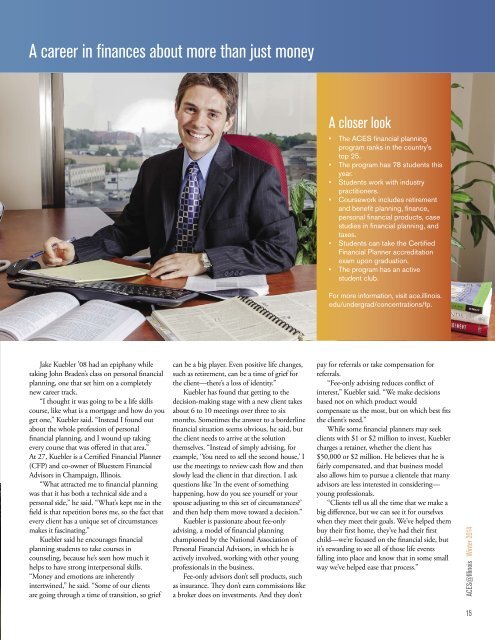t7W0J
t7W0J
t7W0J
You also want an ePaper? Increase the reach of your titles
YUMPU automatically turns print PDFs into web optimized ePapers that Google loves.
A career in finances about more than just moneyA closer look• The ACES financial planningprogram ranks in the country’stop 25.• The program has 78 students thisyear.• Students work with industrypractitioners.• Coursework includes retirementand benefit planning, finance,personal financial products, casestudies in financial planning, andtaxes.• Students can take the CertifiedFinancial Planner accreditationexam upon graduation.• The program has an activestudent club.For more information, visit ace.illinois.edu/undergrad/concentrations/fp.Jake Kuebler ’08 had an epiphany whiletaking John Braden’s class on personal financialplanning, one that set him on a completelynew career track.“I thought it was going to be a life skillscourse, like what is a mortgage and how do youget one,” Kuebler said. “Instead I found outabout the whole profession of personalfinancial planning, and I wound up takingevery course that was offered in that area.”At 27, Kuebler is a Certified Financial Planner(CFP) and co-owner of Bluestem FinancialAdvisors in Champaign, Illinois.“What attracted me to financial planningwas that it has both a technical side and apersonal side,” he said. “What’s kept me in thefield is that repetition bores me, so the fact thatevery client has a unique set of circumstancesmakes it fascinating.”Kuebler said he encourages financialplanning students to take courses incounseling, because he’s seen how much ithelps to have strong interpersonal skills.“Money and emotions are inherentlyintertwined,” he said. “Some of our clientsare going through a time of transition, so griefcan be a big player. Even positive life changes,such as retirement, can be a time of grief forthe client—there’s a loss of identity.”Kuebler has found that getting to thedecision-making stage with a new client takesabout 6 to 10 meetings over three to sixmonths. Sometimes the answer to a borderlinefinancial situation seems obvious, he said, butthe client needs to arrive at the solutionthemselves. “Instead of simply advising, forexample, ‘You need to sell the second house,’ Iuse the meetings to review cash flow and thenslowly lead the client in that direction. I askquestions like ‘In the event of somethinghappening, how do you see yourself or yourspouse adjusting to this set of circumstances?’and then help them move toward a decision.”Kuebler is passionate about fee-onlyadvising, a model of financial planningchampioned by the National Association ofPersonal Financial Advisors, in which he isactively involved, working with other youngprofessionals in the business.Fee-only advisors don’t sell products, suchas insurance. They don’t earn commissions likea broker does on investments. And they don’tpay for referrals or take compensation forreferrals.“Fee-only advising reduces conflict ofinterest,” Kuebler said. “We make decisionsbased not on which product wouldcompensate us the most, but on which best fitsthe client’s need.”While some financial planners may seekclients with $1 or $2 million to invest, Kueblercharges a retainer, whether the client has$50,000 or $2 million. He believes that he isfairly compensated, and that business modelalso allows him to pursue a clientele that manyadvisors are less interested in considering—young professionals.“Clients tell us all the time that we make abig difference, but we can see it for ourselveswhen they meet their goals. We’ve helped thembuy their first home, they’ve had their firstchild—we’re focused on the financial side, butit’s rewarding to see all of those life eventsfalling into place and know that in some smallway we’ve helped ease that process.”ACES@Illinois Winter 201415


